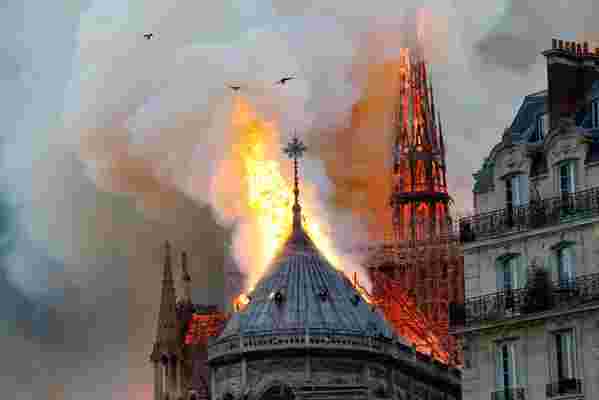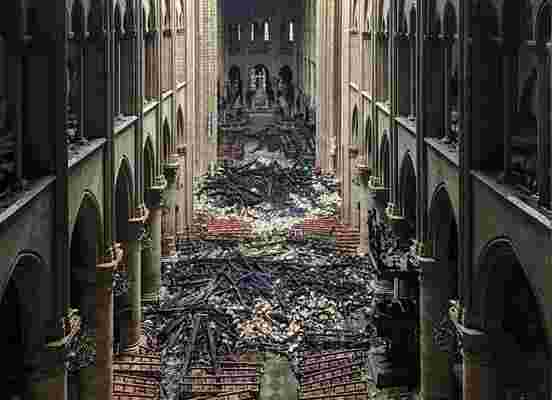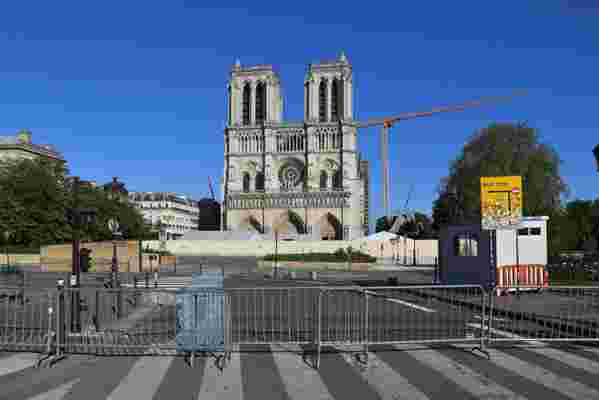One year ago today, the beloved Notre-Dame cathedral in Paris went up in flames , causing great anguish not only in France but across the world as people lamented the destruction of a nearly 860-year-old piece of history and architectural legacy. Fortunately, not a single life was lost during the blaze—and most of the cathedral’s structure, plus its stained-glass windows and many of its priceless artifacts, was spared. What was destroyed, however, was the 19th-century oak-and-lead spire by architect Eugène Viollet-le-Duc, the great wood roof known as “the forest,” and the vaulted ceiling, which was crushed when the spire and roof collapsed through it. In the time since the tragedy, there have been great discoveries, plenty of controversies, and an uplifting development that was just announced today. Here’s all you need to know.

Notre-Dame in flames on April 15, 2019.
The Tragedy
A smoke detector first alerted building staff to a fire in the attic at 6:18 on April 15, 2019, and the flames spread rapidly through the wood structure as onlookers watched in horror. By 9:45 the hundreds of firefighters on the scene had the blaze under control, but the spire and roof—which were undergoing restoration at the time and clad in 350 tons of scaffolding—had already collapsed. Investigators deemed the fire to have been started by either a cigarette or a short circuit in the electrical system. Remarkably, there was relatively little damage to the interior of the cathedral beyond that caused by smoke and water. “There was a lot of luck in this fire,” restorer Emma Isingrini-Groult told TIME .

The interior of Notre-Dame following the fire.
The Aftermath
Many of France’s elite pledged hundreds of millions of dollars to the cathedral’s restoration fund, alongside numerous other corporate and private donors, though it took more than six months for all of those donations (which totaled nearly $1 billion) to be transferred to the appropriate charities.
Work started immediately on the cathedral, from using robots to remove debris to stabilizing the fused-together shell of the scaffolding from the spire’s restoration. But there’s a silver lining to the fire: Scientists and historians are now able to research the cathedral’s original construction methods and materials thanks to the refuse that’s been carted out of the building. One discovery has overturned the previously held assumption that “the forest” was built from medieval oak trees. As it turns out, many parts of the roof structure were much more modern, built between the 17th and 19th centuries.
Controversy Over the New Spire
One of the biggest challenges facing the restoration project is what to do with the roof space. Many want to restore the 19th-century spire to its previous state, but others are in favor of a brand-new design—it’s been a spirited debate since the fire. Last year, France’s Prime Minister Édouard Philippe launched a contest to determine the design of the roof and spire (the fate of the new World Trade Center in New York, where Architectural Digest ’s offices are located, was determined in the same manner) though no winner has been announced. Proposals have varied greatly , from the more outlandish, like a rooftop swimming pool suggested by Stockholm-based Ulf Mejergren Architects, to the more subdued, such as Spanish firm POA Estudio’s idea of an ethereal spire that recalls the 19th-century structure’s form, but reimagined with contemporary style and materials.

The cathedral on April 14, 2020, during the coronavirus pandemic lockdown.
The Restoration’s Progress
French President Emmanuel Macron originally stated that the cathedral would be fully restored by 2024, the year Paris still plans to host the Summer Olympics. But restoration work has currently ceased due to the coronavirus pandemic and the lockdown in place in France, inevitably leading to delays. And there’s great worry that the fused-together scaffolding, which is still stuck atop the cathedral, could collapse and further damage the structure.
The ultimate resource for design industry professionals, brought to you by the editors of Architectural Digest
Still, there’s hope on the horizon. Just today, Germany announced that it will aid France in the restoration of the stained-glass windows, providing monetary aid and the assistance of its experts. If all goes well over the next few years, it’s likely that visitors may be able to enter the cathedral once again by 2024—in fact, a small service was held on Good Friday inside Notre-Dame and live-streamed to worshippers around the world.
